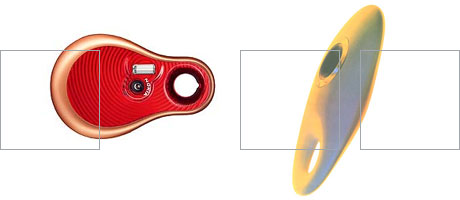    |
|
weblog
July 30, 2003 Design PDF-athon. Just discovered that the Design Council in the UK has great overviews on key design disciplines in the About Design section of its website, with more areas to be covered in the near future. I'd like to think this was all part of Richard Eisermann's recent appointment as the Council's Director of Design and Innovation... The Design Process section includes User Centered Design (download PDF here, 70 Kb), while in What is Design you'll find Ergonomics (download PDF here, 65 Kb) and Information Design (download PDF here, 50 Kb). Interaction Design aficionados should also check out the pages dedicated to Interaction Design (download PDF here, 72 Kb), written by none other than Nico Macdonald. While you are at it also do read another article, "From chaos to constellation: Creating better brand alignment on the Web" (download PDF here, 208 Kb), which relates the difficult task of aligning the User Experience of the many sites of a financial services information provider; a very through case study with nuggets on process and reasoning applied (via Mike Lee). See, a PDF bonanza, in the midst of PDF bashing and PDF-basher-bashing. ;) Posted by fabio sergio | 1:26 PM | permalink ............ July 25, 2003 Linklogging. A couple of voices and places I've been enjoying lately: Chris Heathcote's Anti-Mega, and Clive Thompson's Collision Detection. Thanks to Clive here's "Is It Just My Imagination?", which looks at how Microsoft researchers have been looking at using Rorschach-like inkblots to enable people to create and remember fraud-proof passwords. 
The fact that these visual clues help not only in creating, but also in remembering complex sequences of letters and numbers immediately brought to mind Memory Palaces. I have a feeling that the association between inkblots and passwords taps into the same cognitive process, loading an image with the power to evoke a semantic content that has been attached to it. Also worth a visit: the ArtBots Show, held at NY's Eyebeam Gallery a few days ago (via May). My favorites: The Automated Architecture Bot, 50 Drones and the Scratchrobot. Posted by fabio sergio | 12:07 PM | permalink Comments. I know, my comments are (understatement) not working properly. It seems like the folks over at Enetation are having server problems. Hopefully things will soon improve. Sorry. On the other hand you have no idea how gratifying and motivating it is to see others joining in on the conversation, so if you have anything to rant or rave about please do let me know anyway. Not sure if it's just me, but running a weblog sometimes feels like Speaker's Corner on the home planet of the invisible man, a fool blabbering away in front of a transparent crowd. Ok, in my case the term "crowd" hardly applies. Small group? Friends and family? Posted by fabio sergio | 11:15 AM | permalink ............ July 24, 2003 Innovation. Consolidation. A few weeks ago I attended the end of year show at Interaction Design Institute Ivrea, which meant pleasant conversations with the likes of Molly, Nathan, Mike, Richard, and with many proud graduating students. I had taken part to IDII's opening ceremony, and it felt great to see the school deliver on its promises in the mist of grim economical conditions. All of the theses where inspiring, and even though I throughly enjoyed the almost-ready-for-the-market work of students like Oscar Salazar or Jan Raposa I was (as usual) fascinated by more visionary, abstract projects, such as Ryan Genz's Embedded Theater, which explored location-based storytelling, Natasha Sopieva's It.Self, four prototypes that played with self-referentiality and themes such as life, death and identity, and David Slocombe's UbiMe, which looked at how designers need to consider context not as something that surrounds people, but as the world of meaning people bring with them in terms of personal experiences, which in turn shapes their perceptions and biases. While utterly admiring the work of students and researchers, in the end I could not suppress a thought. Even when it comes to research we are for all purposes in a moment in time in which consolidation reigns over innovation. In other words all the interesting work done at Ivrea over the past year fully won my respect for the quality of the process applied and final outcome, but in my humble opinion caused few "ha-ha" moments. I thought at first the feeling came from the fact that what most of the students showed worked, in prototyping and often business terms, but I later realized it instead had to do with the way in which most projects could be labeled as belonging to one (or more) of the many themes that have been burning hot in the past few years: social computational pervasiveness, geo-located info-tagging, informed spaces, personal publishing, (digital) self-expression, wearables, haptics, smart textiles, social software, emergent e-democracies. It is also true that one of Ivrea's overt goals is to forage companies with innovative ideas, as attested by the panel moderated by John Thackara which included representatives from Telecom Italia, Hitachi and Sony, all sponsors of the Applied Dreams workshops, so it makes perfect sense for IDII to indicate paths that might take its partners places where near-term economical value is very likely to be found. After all even the venerable Media Lab has had to relinquish desires of omnipotency and provide evidences of shorter-term benefits for its (paying) sponsors. But still part of me is left wondering. At what scale is innovation still possible today? Only at the micro-scale? Have we simply looked long enough into our own future, so that we now have to wait for it to catch up with our visions of it, to allow it to become real before we are given the freedom to imagine it again? Or have we maybe seen the end of innovation as something created by the enlightned few, as the MIT's own User Innovation pages seem to indicate, and in the future we'll need to look at the street to provide insights and ideas on how to develop new tools and contexts where to use them? What do you think? Posted by fabio sergio | 4:46 PM | permalink ............ July 23, 2003 Time, a slight reprise. Back from a few days of "vacation", spent trying to organize with Valeria the logistics of our fastly-approaching wedding. I must admit we have somewhat underestimated what it takes to work out the details of such an event, possibly relying on the fact that it will be an intimate ceremony, with only close relatives and friends attending. Weddings in Italy are serious business, to the point that whenever we mentioned "October", as in this October, people invariably asked "Of which year?". I kid you not. In any case I can happily attest that invitations are almost ready (thanks to Davide Longaretti's invaluable help), Valeria has chosen a dress (no easy feat, I must confess), we have narrowed our choice of restaurants to a couple of equally pleasant alternatives, a semi-official photographer has been chosen and also rings are go. Still missing: flowers. Working on it. The return to my daily routine, even though spiced up by a quick, pleasant business visit to the UK, hasn't made me overly enthusiastic. Need to find a cure to these blues, will kindly accept suggestions. It also looks like my previous entry on time, mobile phones and watches was a bit too cryptic, so that the focus seemed to be on time-tracking tools, when it was originally meant to be on time itself. Mobile connected devices have already started changing the way we collectively relate to the passing of seconds, freeing us from rigidly planned arrangements and allowing us to rely on connectivity to constantly re-schedule our daily activities, but that said, what are the long-term implications of this trend? I am not talking about projects such as IDII's Fluid Time, which focus on ways to solve problems already associated with some of these changes, I am talking about our culture's very model of time. During the past week I spent a few hours rummaging through my college books, and dug out Sandra Bonfiglioli's excellent "L'Architettura del Tempo" (The Architecture of Time). The book is a fascinating, in-depth analysis of how the philo-socio-economical concept of time has evolved in the western world, from the natural light /darkness cycles of early agricultural villages, to the discrete time of the church bells of medieval cities, to the split-second precision of the clock of industrial urban settings. The book, dated 1990, only hinted at what the model of time in the "città multimediale" could have ended up being; 13 years later we are experiencing it. Let me thus rephrase my original question. Are we simply changing our time-tracking tool of choice, or is that a reflection of the fact that the way we relate to time is changing altogether? As we smoothly shift into a world socially and economically shaped by 24X7X365 scenarios, will we find ourselves living in contexts where time has actually become fluid? Posted by fabio sergio | 1:10 PM | permalink ............ July 11, 2003 Time. How many times have you heard the phrase "I don't wear a watch anymore, I use the clock of my mobile phone."? Well, I found myself wondering, should it be taken at face value, or there's a truth that runs deeper that the sheer sequence of words? Are people leaving watches at home because they have simply adopted another time-keeping tool, or because the "time of the clock" has ceased to matter? Posted by fabio sergio | 3:16 PM | permalink Radiocommuting. The only positive aspect of driving to Milano each day is Italian public radio. When I find my way back home, around 8 PM these days, I usually listen to Patrizia Carrano's daily program. She talks about women of the past considered to be scandalous, in the sense that they simply refused to behave by what the moral values of their time deemed "appropriate" for women. The reading is interspersed with music, leaving the mind free to evoke what the narrator's voice just described. Yesterday it was the turn of Isadora Duncan, who in many ways single-handedly shaped what we have come to call modern dance. Lulled by my diesel-powered Yo-Yo silent hum, the tale of her tumultuous, tragedy-stricken life slowly unfolded, a tired sun gleaming red on home-bound dirty windshields. Posted by fabio sergio | 3:13 PM | permalink ............ July 10, 2003 Pointing. Shooting. Point-n-shoot videogames are among the oldest known species when it comes to the short history of the evolution of screen-based, interactive digital entertainment. Targeting a virtual opponent and clicking a button to see it turn into pixelated vapor has evolved from the abstracted, black-and-white grace of asteroids, to the nausea-inducing polychromatic excitement of Doom-like massacres. The time is ripe for the next leap, and thanks to companies like GeoVector "point-n-shoot" will soon take on quite literal a meaning, with mobile phones instead of chainsaws, and real people acting as targets. In other words we are bound to soon leave Flatland, on a pilgrimage that will take us from artfully juxtaposed polygons back to our polises, from the kaleidoscopic glow of our screens to the sunlit surfaces of our cities. Further still lie urban scenarios in which sword and gun-wielding, self-appointed heroes will keep hordes of invisible invaders at bay. We thought that cities filled with people busy talking to themselves were strange enough a sight, but the location-based rollercoaster ride will hold quite a few surprises. Just don't leave your valuables in your pockets, they might fall out as you're spinning. Posted by fabio sergio | 2:53 PM | permalink ............ July 09, 2003 Inspiring. David Lu's ForkInSocket. Dario Buzzini's Pollinating Consciousness. The 20th Century Voyage (Mac-only) screensaver (via Antipixel). Posted by fabio sergio | 6:23 PM | permalink ............ July 08, 2003 Backlogging. I tend to assume that whoever reads these pages is also a frequent visitor of sites like Purse Lip Square Jaw, V-2, Girlwonder, Diary of a Superfluous Man, Peterme, City of Sound or Blackbeltjones (just to mention those that sport a weblog), so I often neglect to point to things happening there. This not to mention the fact that I honestly think that whatever Anne, Adam, Molly, Jonathan, Peter, Dan or Matt have to say is usually much more valuable than whatever is to be found on freegorifero. All of this to say that, in case you have missed it, the first Moblogging Conference, held last week in Tokyo and organized by none other than the inimitable Mr. Greenfield, has been a success, and I have a strong feeling that we'll see it pop up again somewhere else next year. As Adam says in his presentation, "Whatever Happened to Serendipity", it is not the idea of making thoughts and pictures instantly available to the world via wirelessly connected means that matters in the end, what matters is what world is taking shape where people, places and information intersect, and how everyone can play a role in making that world a place worth living in. Anne's (draft) paper, "Resonances and Everyday Life: Ubiquitous Computing and the City", also strikes similar chords, but the resulting harmony plays on a slightly different register. The essay courageously and creatively spans from research projects in the area of Ubiquitous Computing all the way to ethno-anthropological studies, pointing at how the output of social and cultural sciences might just be the missing ingredient needed to enable UbiComp to deliver on its originating goals and promises. Both Adam's and Anne's thoughts resonate with elusive ideas I've been jotting down in the past weeks, but inspiration and motivation are scarce resources at freegorifero these days, so, just like me, you'll have to be patient. Not that you were waiting anyway, were you? ;) Posted by fabio sergio | 3:37 PM | permalink ............ July 04, 2003 Screens, buttons, wheels, menus. I have been using a Sony Ericsson P800 for a while now, and must admit I've fallen in love with it and its Sony-inherited JogDial. The little 3-way clicking, scrolling wheel basically allows you to one-handedly do most things you usually do with a phone, leaving the device's handy stylus and touch-screen for more complex tasks. 
My humble take is that Sony Ericsson has used the P800's removable keypad and JogDial to avoid scaring the large public away with a PDA-only-looking device. A smart move, all in all. Using the JogDial also helped spark thoughts of slightly different nature. Most mobile phones can hardly claim to be successful at creating a compelling User Experience as the "incarnation of brand values over time", especially when considering how their "hard shell" interacts with the "soft" arrays of pixels, inside the screen. Comparing almost any two handsets from practically any producer you could probably argue (and test) that one will be "easier to use" than the other, but I'd be surprised if you could tell the difference between the two from an interaction style standpoint, other than a few subtle differences. Today what you can expect are a few icons on the first level followed by the ever-lengthening sequence of text-based menus, which usually force the user through tedious decision-making processes. Create message? Add contact? New one? Edit existing? Send now? Are you sure? Are you really sure? This action cannot be reversed, are you really, really sure? Yes, you were. This is the result of usability dominating over all the other experience factors, as clearly pointed out in ID Studiolab's "Interaction relabelling and extreme characters: methods for exploring aesthetic interactions" (download PDF here, 603 Kb): "Aesthetics and interaction are often treated as separate concepts ... a situation to which we strongly object. When they are separated, aesthetics are usually applied to making products desirable in appearance, while interaction design is preoccupied with usability, and particularly "ease of use". While usability is often a laudable goal, it isn't enough. Focusing on ease of use tends to encourage a narrow view of what "use" is with respect to technology, emphasizing efficiency and productivity over exploration or curiosity. With a correspondingly narrow range of models for usability, interaction tends to be self-similar, mundane, and ultimately boring." It quickly becomes thus clear why differentiating UI factors are likely to be associated with solid-side input mechanisms, like Sony's JogDial or Nokia's NaviRoller. The impact these hardware features have on the design of the User Interface can be strong enough to help drive a sense of uniqueness, ultimately leveraged to develop a competitive advantage. Clear evidences are Sony's decision to use its JogDial on devices as diverse as phones, PCs and PDAs, or Nokia's older attempts at transferring the NaviRoller from mobile phones to Interactive TVs. It is also worth noting that the solid side of the UI is almost ready to take a leap into the future. Recent examples include devices that can be operated simply by moving them, like MyOrigo's upcoming product, or haptic tools that will be operated by flexing their malleable casing. On the more traditional side many companies are still looking at making data input easier, from models sporting ever-shrinking QWERTY keyboards, like the hyped new Treo 600, to new concepts such as the odd-looking Fastap keypad from Digitwireless, which recently signed deals with the likes of Intel and Microsoft. The other major change we can expect is for mobile tools to start relating to the real world in a much more direct way, whether because of the increased use of sensors inside the product or around it. Many phones already sport A-GPS and compass enhancements, which will allow them to display information in a context-related manner, with the most basic example being that of phones able to display maps and to orient them automatically based on the holder's position and movement in space. The way all of these features will have an impact on how devices will be controlled can only be guessed at the moment, but we can expect that we'll soon start to see tools that are "more aware of their surroundings", as Nathan would probably say. Examples above notwithstanding most mobile tools today adhere to well-known, not necessarily fittest-to-the-task, Graphic/Solid UI feature-sets, and this is especially true when considering touch-screen devices. How many PDAs can you mention in the next 10 seconds that have substantially more (or less) than 4 physical buttons and some sort of navigation widget, not including those that sport a mini QWERTY keyboard? Thought so. Reasons are a-plenty, from the ones mentioned above to those related to hectic production processes. Due to ever-shortening product life-cycles, industrial products are usually developed following what has been dubbed "extreme parallelism": all phases happen at the same time. This in my experience usually means that the software/UI team hacks away at its bit while another team is doing its best with the definition of the product's design and engineering , and other than initial agreements the two teams hear very little about what the other one is doing until integration time (this not to mention common cases in which the UI team and the software development team are also working in parallel). The result is that most touch-screen devices end up looking like a squarish screen with a few keys (neatly and pleasantly) organized around it, and all the action relegated under the glassy surface. This is definitely also standardization at work, but the risk, as always, is for standardization to lead to "lock-in" before a design has proven be the best answer to the problem it attempts to solve, especially with the ever-shifting changes associated with digital tools and their mobile incarnations. After all history teaches that standards can survive beyond our wildest expectations, as anyone still typing on a QWERTY keyboard (not originally designed to slow typists down, thanks Carsten!) can easily attest...the same keyboard layout that is now finding its way onto many mobile devices. If nothing else, that should have us thinking. Posted by fabio sergio | 5:45 PM | permalink ............ July 03, 2003 Tools for Tales. Personas and scenarios can be very powerful design tools, both internally (within a team) and externally (with a client). The simple reason being, in my humble opinion, that we can all easily relate to a well-written narrative: scenarios allow anyone in product development to use a shared vocabulary, the one we learned hearing our mother's bedside tales, reading comics and books, watching movies. If you are new to the subject, Whitney Quesenbery's slightly oldish "Storytelling: Using Narrative to Communicate Design Ideas" (download PDF here, 90 Kb) is still a good introduction to the subject. On the other hand, to be effective, personas and scenarios need to reflect real users, goals, mindsets and contexts, or the risk is to create profiles that lack effectiveness in conveying people's overt and latent needs and desires. To that extent Lene Nielsen's DIS2002's "From User to Character" (download PDF here, 320 Kb) is an interesting critique of current persona design processes, and points out the potential downsides of creating hollow stereotypes. That said, narrative techniques are also great when involving users early in the design process, especially during initial conceptualization phases. Getting people to describe situations, tools and associated emotions in the form of a tale helps them feel as spectators of their own actions, thus helping to suspend judgment and self-awareness. It also fosters creativity and makes the exercise fun. Unfortunately not everyone is feels comfortable at telling stories, so having a "narrative toolkit" available greatly enhances the potential for success. To that extent do read Sonic Rim's (oldish) white papers, among which I still find "Harnessing People's Creativity: Ideation and Expression Through Visual Communication" (download PDF here, 180 Kb) particularly valuable. "The people who buy and use the products we create are not typically invited to play in the fuzzy front-end of the development process because it is commonly believed that they are not creative. But participation early in the front-end is needed to drive truly human-centered product development. We have learned how to harness the creativity of potential end-users very early in the development process. The research methods in this [paper] explore not only what people say and do, but also what people make. The say methods are rooted in verbal communication and are used in situations such as traditional focus groups. Methods such as applied ethnography focus on what people do through direct or indirect observation. The make methods are unique in their ability to elicit creative expression from everyday people. This [paper] describes and shows examples of "make" toolkits we use to elicit creative thinking from people who will buy and use future products and services. It also outlines how all the methods (say and do and make) are used together in order to fully understand people’s past, present as well as anticipated experiences with products and services." Truth is you often don't need much: magazines and random pictures and objects can be highly effective. At Razorfish Milano we created a simple dedicated card deck that included images from the natural world, machinery, random words and colors, and were amazed at seeing how people naturally used them to sketch out simple flows with quick card associations, or evoked emotions with pictures and colors, mood-board style. IDEO has also created beautiful, very elaborate Method Cards, which are even available for sale. Whether you decide to go the Lo-Fi, do-it-yourself route, or to purchase existing cards I advise you to just try similar techniques out, you'll be surprised. Posted by fabio sergio | 4:34 PM | permalink ............ July 02, 2003 Essensuality. Nokia keeps courageously exploring new directions on the market, the digital Fun Camera being one of the latest examples. The product strangely resembles the "Eye", an analogous, more elegant concept conceived by Ross Lovegrove for Olympus in 1995, which was never put into production. The similarity is puzzlingly, but the idea of staring into a simple hole to aim and shoot it's still an intuition that's hard to beat in terms of sheer perceived simplicity. 
Separated at birth: the Nokia Fun Camera (2003, left), and the Olympus Eye concept camera (1995, right). Lovegrove has always been a master at creating what can be called essensual objects, artifacts that have shed any superfluous defining element, but have also been able to retain the elusive quality of appealing to the senses, rejecting easy alternatives offered by reductionist interpretations of minimalism. In the case of the Olympus camera mentioned above, for example, Lovegrove used a soft latex rubber case to create a product that begged to be touched and squeezed, in a period in which the dominating design language of technology still used a vocabulary inspired by the esthetic of the machine, brushed metal, black plastic, tight edges and all. Maybe because of his overt references to the work of Henry Moore, or for his organic, nature-inspired shapes, like Luceplan's Pod and Bud lamps, or maybe simply for his understated visionary qualities, Lovegrove's work has always moved me. Possibly part of a feminization trend pointed out by people like Patrick Jordan, essensualism is also, in my humble opinion, the quality behind the highly successful Apple products of the recent past. From the curvaceous, translucent, plastic shapes of the original iMac, to the understated, sensuous honesty of titanium PowerBooks and brushed aluminum G5s, the inspired products designed by Jonathan Ive's team have a lot to thank designers like Lovegrove in terms of inspiration. Posted by fabio sergio | 12:56 PM | permalink ............ July 01, 2003 The (Go) Game. Reminiscent of similar recent endeavors, like the London-based Uncle Roy All Around You, and not far from a Lo-Fi take on the plot of the movie The Game, The Go Game (via Marc Canter) is possibly one of the first commercial plans to leverage connectivity and mobile tools to turn the world into a giant playground. "The Go Game is an all-out urban adventure game. Through clues downloaded to a wireless device and hints planted in unlikely places, you'll be guided through a city you only think you're familiar with. Clues can appear at any time, anywhere. Perhaps you didn't notice the woman on the bus reading a magazine upside-down. Or the note stuck to the side of the bathroom mirror of your favorite bar, or the electric scooter parked outside with your name on it. After a day of Go, you will. The Go Game relies on the very latest in wireless technology, keeping the game moving with a constant give-and-take of digital information. Teams of 4 to 6 players compete with one another to complete a sequence of creative challenges or "missions" in the most ingenious, daring, creative fashion. We track your heroic deeds as you go along, verifying your location and the time it took to complete each mission." Now, for all purposes this is no more than a carefully crafted experience, based on an agreement among team members to collectively suspend judgment and play pretend. Experience Design community members, are you listening? Posted by fabio sergio | 5:49 PM | permalink Close calls. During the last week-end Valeria and I drove to Trento to see our newly-born nephew Luca, then waded through bumper-to-bumper traffic during a hellish 5-hour odyssey back to Varese on Sunday night. Yesterday morning then, during my daily commute to work, I escaped a car accident by sheer seconds. I basically slow-motioned (or so it felt) through flying debris as the Opel in front of me crashed into a nearly-still Renault, lifting the French lightweight off the ground and sending it twirling on its roof mere meters from my approaching wheels. I stared in disbelief as the driver of the Renault crawled out of the upturned vehicle in my rear viewing mirror, traffic slowly stopping behind him, like water held fast by a dam of broken glass and bent metal. All of this to say that I should know better than pointing to a GPS-enhanced radar detector, (via Joi Ito) to talk about convergence, wholes, sums and parts. But that's what this entry is supposed to be all about. Connected ice creams do not come in single flavors anymore, and new combinations only seem to encourage insatiable appetites. It used to be all about sensing speed traps as you approached, but now that's augmented with geo-located information about fine-prone spots, blending the best of mobility and stability, with obvious potential for bottom-up updating of databases. High-tech alternatives to the all-Italian habit of flashing your headlights to warn upcoming traffic about waiting policemen, long declared illegal, never really abandoned. From guessing to predicting in one (r)evolutionary step. New tools for Smart Mobs to fight the powers-at-large, walking the fine line between what's legal and what's moral. Needless to say, this is only the beginning. Posted by fabio sergio | 11:11 AM | permalink Notes from somewhere bizarre 2.0. My friend and office neighbor Ashley Benigno has finally decided to update the previous incarnation of his weblog. Notes from Somewhere Bizarre now sports a brand new URL, a clean visual language and Ashley even swore he's going to update it more often than once a year. The RSS feed has already found its way onto my daily dose list. I (warmly) advise you to do the same. Posted by fabio sergio | 11:10 AM | permalink ............ Not bored yet? Visit freegorifero's weblog archives for more useless words. |
updated with blogger |
|
| © freegorifero.com This web site is licensed under a Creative Commons License. Some rights reserved. |
|